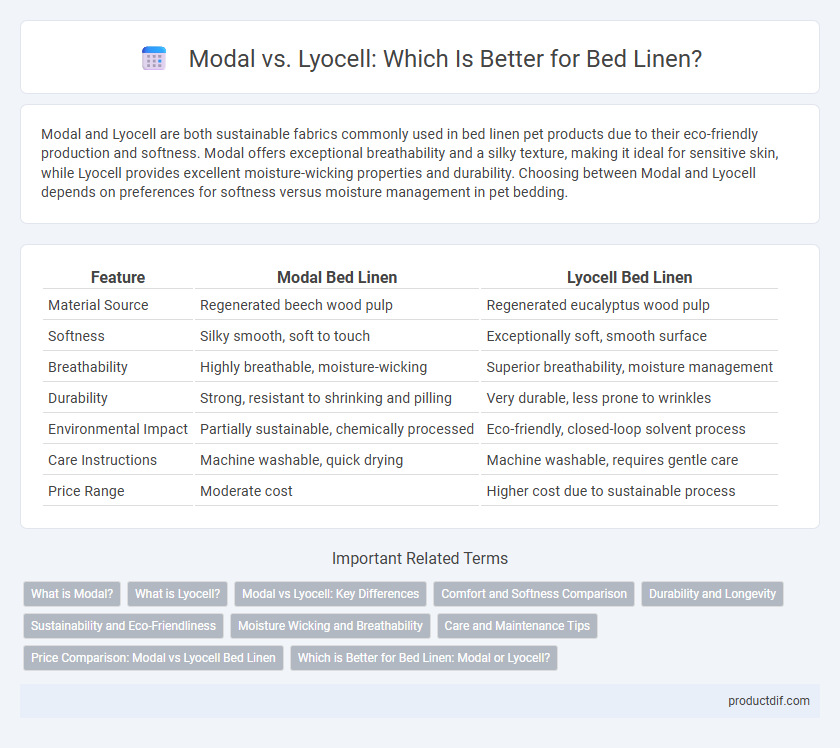Modal and Lyocell are both sustainable fabrics commonly used in bed linen pet products due to their eco-friendly production and softness. Modal offers exceptional breathability and a silky texture, making it ideal for sensitive skin, while Lyocell provides excellent moisture-wicking properties and durability. Choosing between Modal and Lyocell depends on preferences for softness versus moisture management in pet bedding.
Table of Comparison
| Feature | Modal Bed Linen | Lyocell Bed Linen |
|---|---|---|
| Material Source | Regenerated beech wood pulp | Regenerated eucalyptus wood pulp |
| Softness | Silky smooth, soft to touch | Exceptionally soft, smooth surface |
| Breathability | Highly breathable, moisture-wicking | Superior breathability, moisture management |
| Durability | Strong, resistant to shrinking and pilling | Very durable, less prone to wrinkles |
| Environmental Impact | Partially sustainable, chemically processed | Eco-friendly, closed-loop solvent process |
| Care Instructions | Machine washable, quick drying | Machine washable, requires gentle care |
| Price Range | Moderate cost | Higher cost due to sustainable process |
What is Modal?
Modal is a type of semi-synthetic fiber made from beech tree cellulose, known for its exceptional softness and breathability. It offers excellent moisture-wicking properties and resists shrinking and pilling, making it a popular choice for bed linen. Modal's smooth texture and durability enhance comfort and longevity in high-quality bedding products.
What is Lyocell?
Lyocell is a sustainable fabric made from cellulose fibers derived from hardwood trees such as eucalyptus, showcasing exceptional softness and breathability ideal for bed linen. Its production uses a closed-loop process that recycles water and solvents, making it an eco-friendly alternative to traditional fabrics. Lyocell bed sheets offer moisture-wicking properties and durability, providing a comfortable sleeping experience while supporting environmental responsibility.
Modal vs Lyocell: Key Differences
Modal and Lyocell are both sustainable fabrics derived from wood pulp, but Modal is made from beech trees while Lyocell comes primarily from eucalyptus trees. Modal is known for its softness and excellent moisture-wicking properties, making it ideal for breathable bed linen, whereas Lyocell offers superior strength, wrinkle resistance, and eco-friendly production processes. Modal tends to have a more luxurious, silky feel, while Lyocell excels in durability and environmental impact, providing distinct benefits depending on bed linen preferences.
Comfort and Softness Comparison
Modal bed linen provides exceptional softness and a silky texture due to its high moisture absorbency and fine fiber structure, making it ideal for sensitive skin and year-round comfort. Lyocell bed linen, derived from eucalyptus trees, offers superior breathability and moisture-wicking properties, enhancing coolness and comfort during warm nights while maintaining a smooth and durable feel. Both materials outperform traditional cotton in softness and comfort, with Modal excelling in softness and Lyocell shining in moisture management and temperature regulation.
Durability and Longevity
Modal bed linen offers excellent durability due to its resistance to shrinkage and pilling, ensuring prolonged softness and a smooth texture over time. Lyocell, made from sustainably sourced eucalyptus fibers, combines strength with moisture-wicking properties, promoting long-lasting freshness and reduced wear. Both fabrics maintain shape and color retention, but Lyocell's eco-friendly production and resilience to abrasion make it a superior choice for extended use.
Sustainability and Eco-Friendliness
Modal and Lyocell are both sustainable fibers derived from renewable wood sources, with Modal primarily made from beech trees and Lyocell from eucalyptus. Lyocell is produced using a closed-loop process that recycles water and solvents, making it highly eco-friendly and biodegradable. Modal, while also sustainable, uses a more water-intensive process and typically involves chemical treatments, resulting in a slightly larger environmental footprint compared to Lyocell.
Moisture Wicking and Breathability
Modal bed linen offers excellent moisture-wicking properties due to its semi-synthetic fiber structure, efficiently drawing sweat away from the skin to keep sleepers dry and comfortable. Lyocell, derived from sustainably sourced wood pulp, provides superior breathability with its smooth, porous fiber composition that enhances air circulation and reduces heat retention. Both fabrics excel in moisture management, but Lyocell typically surpasses Modal in maintaining a cooler sleep environment through enhanced airflow.
Care and Maintenance Tips
Modal bed linen requires gentle washing in cold water to maintain its softness and avoid shrinkage, while using mild detergent helps preserve its smooth texture. Lyocell bed sheets benefit from machine washing on a delicate cycle with cold water, and air drying prevents fabric damage and retains moisture-wicking properties. Both fabrics should avoid bleach and high heat drying to extend their lifespan and keep the fibers strong.
Price Comparison: Modal vs Lyocell Bed Linen
Modal bed linen generally offers a more budget-friendly option compared to Lyocell, with prices typically ranging 20-30% lower. Lyocell, sourced from sustainably harvested wood pulp, commands higher costs due to its environmentally friendly production processes and superior moisture-wicking properties. Consumers seeking a balance between affordability and eco-consciousness may find Modal to be cost-effective, while Lyocell represents a premium investment in performance and sustainability.
Which is Better for Bed Linen: Modal or Lyocell?
Modal and lyocell are both high-quality fibers ideal for bed linen, offering exceptional softness and breathability. Modal, derived from beech trees, is known for its silky texture and durability, while lyocell, made from eucalyptus pulp, excels in moisture-wicking and eco-friendliness. For bed linen, lyocell often outperforms modal in sustainability and temperature regulation, making it a better choice for those seeking environmentally conscious and breathable sheets.
Modal vs Lyocell Infographic

 productdif.com
productdif.com